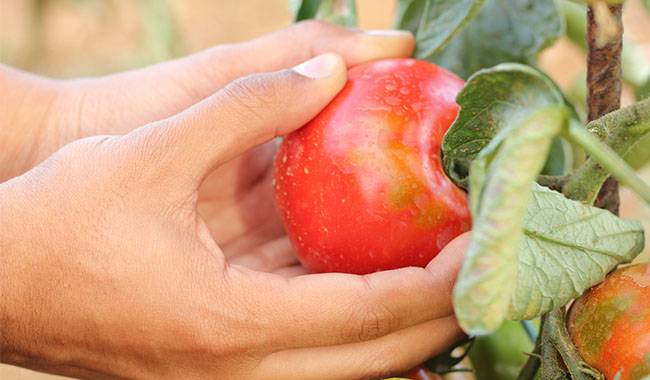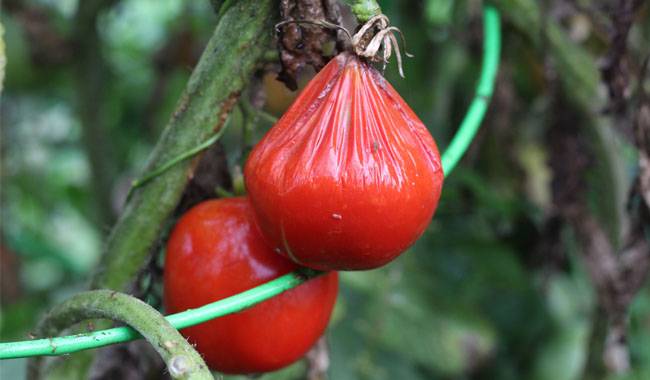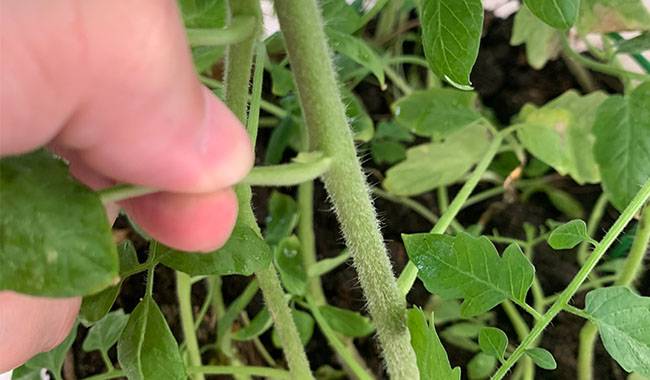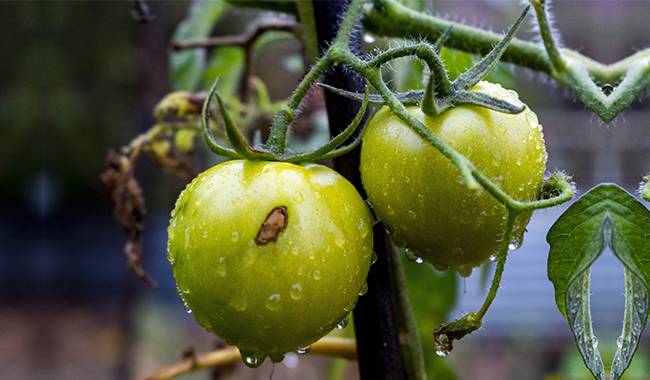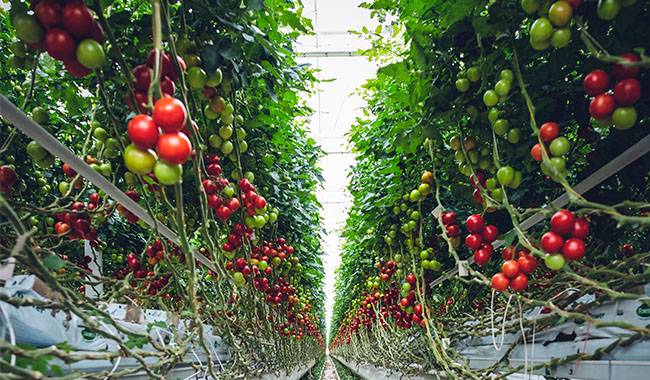
The weather is unpredictable, sometimes cold and rainy, then suddenly hot and dry. I’m not even talking about spring frosts, which can happen in late May or even early June.
How to grow tomatoes in a greenhouse? All of this, as well as significant fluctuations in the daytime and nighttime temperatures, could significantly reduce our summer cottage crop.
However, the climate in the greenhouse is not so dependent on the whims of our changeable weather.
Here, premium tomatoes ripen much earlier and their quality and yield are higher than those grown in open fields.
In this article, we will analyze the nuances of growing tomatoes in a greenhouse.
Growing tomato princes in a greenhouse are different from caring for them in an open garden. In particular, it is important to take into account that tomatoes do not tolerate temperature changes and do not like high humidity.
PREPARE THE GREENHOUSE
Preparation of greenhouses for growing tomatoes should be started in autumn. After thorough removal of all plant residues, we will disinfect the future tomato boarding.
Do not forget to put on yourself a respirator and gloves!
Greenhouse with a wooden frame. It needs to be fumigated with sulfur. We mix sulfur with kerosene and place it along the entire length of the greenhouse on a metal plate located on the floor of the greenhouse.
Cover all cracks in the walls. We set fire to the mixture and let it smother for 5 days. Sulfur will help us to get rid of fungus, mold, infections, and traces of harmful insects.
Greenhouses with metal frames. If there are metal parts in the structure, you cannot use sulfur (it will cause corrosion).
In this case, we spray the walls, ceiling, and soil with a solution of chlorinated lime. Dilute the bleach (400 g) with water (10 l) and leave it for 4-5 hours. After spraying, the room is kept airtight for 2-3 days.
In order to grow tomatoes successfully in the greenhouse, after disinfection, we ventilate the room and thoroughly clean it from the inside with a brush.
Pour boiling water on the metal parts and then pour copper sulfate solution on the wooden surface.
PERFECT SOIL
Ideally, the greenhouse soil should be completely replaced every 5 years. If this is a problem, you can limit yourself to disinfecting it in the fall.
You can disinfect the soil with a solution of copper sulfate, Bordeaux liquid, garden lime, or dolomite powder (50 grams per square meter). You can treat the soil with boiling water.
The roots of tomatoes are extremely susceptible to cold, so it is recommended to plant them on raised beds.
On the advice of an experienced gardener, the beds can be additionally insulated: remove the soil completely from the greenhouse and cover the tomato area with wood chips, pine needles, or straw (the thickness of the insulation is about 10 cm (3.93inch)).
Place the compost on top of it about 10 cm (3.93inch) high and return the soil. Pour it in 20cm (7.87inch) high.
If your soil does not have enough nutrients, apply an organic fertilizer to the soil in the fall (humus + peat, ½ bucket per square meter). In addition to organic matter, you can also put ashes and sand (1 liter per square meter).
Then the soil is covered with straw. When it snows, we bring it into the greenhouse and put it on the straw. This will facilitate the growing of tomatoes in the greenhouse in the future. The snow protects the soil from freezing, while in spring it moisturizes it well.
Natural green fertilizer, which many summer residents successfully use for soil preparation for growing tomatoes in greenhouses.
Beans, lupins, sweet clover, mustard, oats, barley, alfalfa, oats, rape, etc. These are the richest sources of organic matter (3 kg of green manure replaces 1.5 kg of manure).
Two weeks before the appearance of young tomatoes in the greenhouse, it is necessary to close the nutrients to a depth of 2cm-3cm (0.78inch-1.18inch) in the spring.
In the spring we will add to the soil compost or compound fertilizer: nitrification phosphorus, a whole bacterium (1.5 tablespoons per square meter / 1.5 tablespoons), and dig the soil to create ideal conditions for the life of our pets.
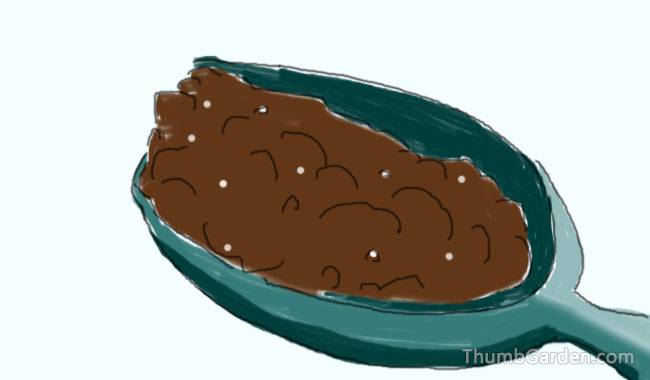
GROWING TOMATOES
Successful cultivation of tomatoes in the greenhouse depends to a large extent on the correct choice of the date of sowing.
If spring arrives at a stable temperature to our satisfaction and on time, then you can plant seedlings.
- Make the glass greenhouses heat: from the end of April to the beginning of May.
- To unheated greenhouses, but with an indoor covering film: from the beginning of May to the middle of May.
- To unheated rooms without additional insulation: from mid-May to the end of May.
- Covered with film in open conditions: mid-May to the end of May.
- The ideal soil temperature for growing tomatoes in a greenhouse is 10°C-15°C (50°F-59°F) and air 20°C-25°C (68°F-77°F).
Just in case, you need to be safe from weather changes and cover the greenhouse with a double layer of film (2cm-3cm (0.78inch-1.18inch) between them).
When the night temperature is stable and warm (usually in June), you can eliminate the cold protection.
TOMATO GROWING PLAN
How to grow tomatoes in a greenhouse for maximum yield? First, plan the placement of tomatoes correctly.
However, it is quite difficult to put the landing pattern under one rule. Every experienced gardener has his or her own opinion on this.
After exploring a number of tips, we offer the most successful tomato planting schemes.
Early maturing, too small varieties: plant in a checkerboard pattern (two rows with a gap of 50-55 cm (19.6-21.6inch) between them), forming 2-3 stems. The distance between bushes is 35-40cm (13.7-15.7inch).
Standard and determinant species: planted 45-50cm (17.7-19.6inch) apart in rows about 25cm (9.84inch) apart between bushes, according to this scheme you can plant in a square. meter with a maximum of 10 tomatoes. But plants planted in this way will require more attention.
Tall giants: staggered planting (75-80cm (29.5-31.4inch) between rows) with 1 stem planted every 55-60cm (21.6-23.6inch) or a gap of 2 stems between rows 70-75cm (27.5-29.5inch).
There is a very well established plan for growing seedlings when growing different varieties of tomatoes in the same greenhouse (although it will provide you with a bumper crop all year round).
According to this plan, grow tomatoes in the greenhouse in two rows.
First row. A place is given to him near the glass (film) at the edge of the greenhouse. Decisive early plants are planted there (at a distance of 35-40 cm (13.7-15.7inch) between bushes), forming a stem. Gradually, the upper stepchild is transferred to the continuation of the stem.
The second row. It is positioned in the internal channel. Every 60 cm (23.6inch) a tall, huge tomato is planted, and they also form a stem.
In the same row, set back about 10cm (3.93inch) to the south, the standard super-determinate species (25cm (9.84inch) gap between bushes) were planted on the giant planets.
They formed a second bud and then pinched into a stem, leaving 2-3 leaves. When our tomatoes ripen, the standard species will bring you a bumper crop.
With this program, you can grow up to 20 giants, 40 determinants, and 50 early maturing in one season. Early maturing plants will be harvested in early July after harvest.
Successful cultivation of tomatoes in the greenhouse also depends on the correct formation of the beds. About a week before tomatoes appear in the greenhouse, they are closed.
The beds look like mounds of soil 30-40 cm (11.8-15.7inch) high and 60-80 cm (23.6-31.4inch) wide (the distance between the two beds is about 60 cm (23.6inch)).
PLANTING TOMATO SEEDLINGS
The optimal age for young tomatoes to transfer them to the adult world is 50 days. By this age, tomatoes already have a strong root system. They are fully prepared for greenhouse conditions.
If the seedlings are very elongated, remove their lower leaves (when planting, place the elongated seedlings a little deeper than usual).
The ideal time to transplant young plants is a day when the nights are warm rather than hot.
- Water the tomatoes heavily 20 minutes before planting. If the roots of the seedlings are too long, cut them off 2-3 cm (0.78-1.18inch).
- Dig holes about 15 cm deep and put hummus in each hole. or a mixture of wood ash (a small amount) and crushed calcium superphosphate (1 teaspoon). Then pour into the holes a dilute solution of potassium permanganate (2 liters per socket).
- Transplant the shrub and its clods vertically onto the first leaves. If the seedlings are too long, place them at an angle and sprinkle the soil over part of the stem. You can plant your seedlings in a greenhouse and use the “mud” method (fill the nest completely with water and transplant the tomatoes into the mud). This will help your roots to distribute more evenly in your new home.
- Compact the soil around the planting and cover it with soil. Cover the top layer of soil. To prevent late blight, you can spray the plants with Bordeaux liquid (100 g liquid per 10 liters of water) or copper trichloride oxide (40 g copper per 10 liters of water).
After transplanting, the seedlings need to be left for a few days to allow the tomatoes to adapt to the new conditions. after 5-6 days, we loosen the soil to improve the oxygen supply to the roots.
In the meantime, garters were installed near each bush when the seedlings were planted. If this is done later, the roots may be accidentally damaged.
There are several methods of tying tomatoes for growing in the greenhouse.
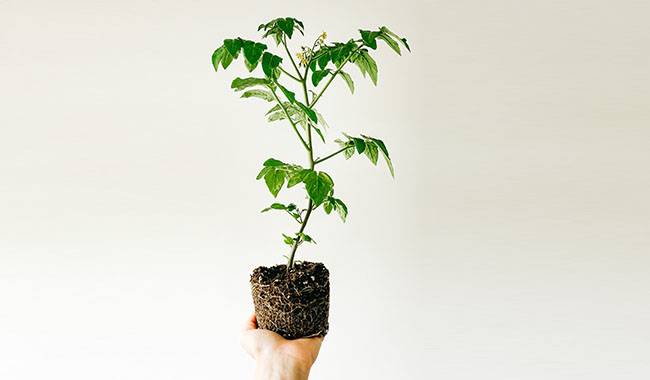
HOW TO HANG TOMATOES
Bracket
The easiest way to tie medium-sized varieties. As stands, you can use thin plastic tubes, metal rods, stakes, or rebar trimmings.
They should be 25-30 cm (9.84-11.8inch) longer than the final growth of the shrub (this is the depth at which the nails will be driven into the ground).
Place them next to the stems. The trunks of the tomatoes are wrapped with garter tape and tied to the supports.
Repeat this process when growing tomatoes in the greenhouse as the bushes grow.
Hanging baskets
Ideal for giant garter belts (species that can grow indefinitely, up to 5-6m in greenhouse conditions).
The lattices allow you to save as much space as possible in the greenhouse. With their help, you can grow up to 3-4 shrubs per square foot.
Push in long stakes along the ridge and pull every 35-40cm (13.7-15.7inch) with a thin twine or wire.
As the bush grows, use the braiding method to tuck its branches and stems between the stretched twine. Using the lattice method, you can also leave the lateral branches to develop, which will greatly increase the yield.
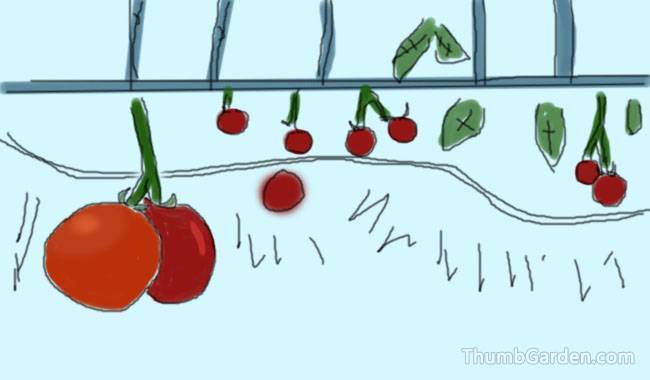
HOW TO PINCH TOMATOES
When the tomatoes reach 15-20cm (5.9-7.87inch) in length, pinch the tomatoes for the first time, carefully cutting off or severing the lateral processes of the tomatoes.
But unfortunately, throw them away. You can keep a few cuttings of the stepchildren.
Put them in water and after a few days, the stepchildren will disappear. They can then be safely transplanted into the open ground.
This is wise if you are growing rare, exotic varieties of tomatoes.
When growing tomatoes in a greenhouse, the stepchildren will gradually move out as the tomatoes grow (pinching is done once a week).
After pouring in the fruit, it is necessary to remove the lower leaves of the tomatoes, leaving the bare stems. This will improve the quality of the bushing ventilation and reduce its moisture.
TOMATO CARE
| Project | How to properly advise | Tips |
| Spraying | 6-7 times throughout the season | You can use crushed garlic (30-40 g per 10 liters of water) |
| Air temperature | 20-25°C (68-77°F), at night 24-26°C (75.2-78.8°F) and 16-18°C (60.8-64.4°F) for full fruit growth, the parameters should be regulated by greenhouse ventilation in all kinds of weather. | Adjust the parameters in all weather by ventilating the greenhouse |
| Air Humidity | 60-65% | Adjust the parameters by ventilating the greenhouse in all weather |
| Watering | The first watering, one week after sowing, is heavy, often 20-25 liters per square meter. 2-3 times a week during the fruiting period, but with more watering [15-20 liters/m2], moderate watering | The ideal irrigation temperature is 18-20°C (64.4-68°F) for early morning watering under the tomato roots |
| Fertilizer | 8-10 days after the first sowing, then alternate every 10-12 days with organic matter and mineral fertilizers, added to the boron fertilizer in the feed | To keep the fruit sweet and increase vitamin C, add boron fertilizer to the feed (1 gram of boric acid per 1 liter of water) |
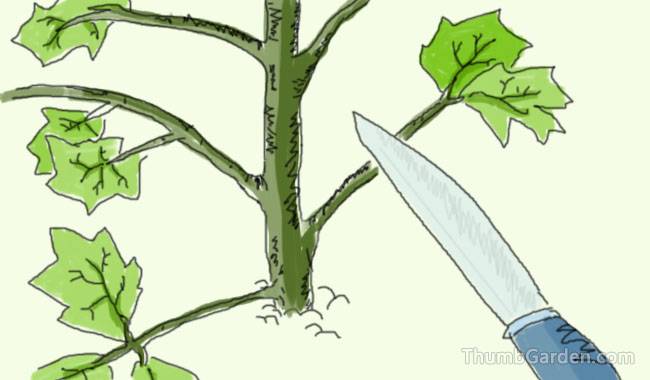
TIPS FOR FERTILIZATION
During the flowering period. Need mineral feed: a mixture of water (10 liters), nitrogen (25 g), potassium (15 g), and phosphorus (40 g). Consumption per square meter / 1 liter.
During the fruiting period. We need organic matter: pour ash (2 liters) into 10 liters, adhere, add iodine (1 bottle) and boric acid (15 g) adhere to the day and night of the execution.
Then dilute the mixture with water in the ratio of one liter per bucket of water. Consumption per bush per liter.
| Deficient elements | Tomato appearance |
| Nitrogen | Thin stems, light green leaves, weak, small inflorescences |
| Potash | Slow growth, blue-green leaves, wrinkled young leaves, poorly developed root system |
| Phosphorus | Thin stems, blue-green leaves, purple along veins, and red spots |
If tomatoes are growing in good conditions, then healthy tomatoes will make their leaves curl slightly during the day and spread out at night, and the color of the large flowers will change to bright yellow.
Sometimes tomatoes on one cluster pour into full, large, beautiful fruit, while on another cluster they turn brown.
If you notice this, remove the brown fruits immediately without waiting for them to ripen. They will ripen calmly in your home.
Pollination
Tomatoes are a self-pollinating plant, but during pollination, if growing tomatoes in a greenhouse, you can help it by tapping the stems or shaking the flower brush.
Hang a jar of honey, spiced jam, or scented syrup near the entrance to the greenhouse. This will attract pollinating insects to the greenhouse, which will make a beneficial contribution to the pollination of the plants.
HARVESTING
You can harvest tomatoes without hesitation. We need to take out the fruit without the daytime temperature falling below 8°C (46.4°F) or the nighttime temperature falling to 0°C (32°F).
The ideal time to harvest is in the morning (during this time the tomatoes are most resilient). Make sure they are not covered with moisture.
It is best to pick tomatoes from a garden bed in a small basket lined with cloth. Or use a bucket of water.
Sort the harvested fruit immediately. Place the less ripe (brown) ones in wooden crates with a capacity of 8-12 kg.
Stack the unripe tomatoes in two or three layers. You can add 2-3 fully ripe fruits to them (ripe tomatoes give off ethylene, a gas that accelerates the ripening of the fruit).
FRUIT RIPENING
To extend the ripening period, place a layer of unripe tomatoes in a wooden crate and keep it at a temperature of 10-12°C (50-53.6°F).
Turn over and remove ripe tomatoes from the crates daily. Maintain air humidity at about 80-85% (at higher levels, the fruit will begin to rot).
In this mode, the ripening period will last 2-2.5 months.
In order for you to have fresh tomatoes in winter, use the following method: 5-6 days before the first frost, dig out tomato bushes with unripe fruits (leave the soil on the roots).
Transfer the plants to the basement and hang the roots upwards on carnations punched into the walls. The optimal temperature is 1-5°C (33.8-41°F). Under these conditions, tomatoes will begin to ripen in early December.
To speed up ripening, sort the tomatoes by size and place them on the shelves with the stems upwards in 3 layers. The room must be very dry, with a temperature of 20-24°C (68-75.2°F).
In this environment, the fruit will ripen within a week.
STORING TOMATOES CORRECTLY
When growing tomatoes in a greenhouse, the fruit will not keep for very long (especially early and medium varieties).
For longer storage, place tomatoes in boxes with a mixture of peat shavings and birch sawdust.
You can wrap each fruit on soft paper.
Some gardeners freeze harvested tomatoes and then place them briefly in cold water before serving.
Frozen tomatoes also store well in wooden boxes under the snow.
Do not store tomatoes in the refrigerator. Colds have a detrimental effect on their aroma. Only put overripe fruits in the refrigerator.
Store fully ripe tomatoes at room temperature, out of direct sunlight. Enjoy your harvest!




